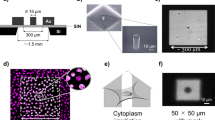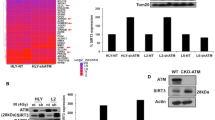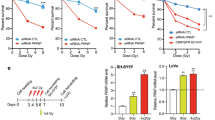Abstract
Ataxia telangiectasia (AT) is a rare human autosomal recessive disorder with pleiotropic phenotypes, including neuronal degeneration, immune dysfunction, premature ageing and increased cancer risk. The gene mutated in AT, ATM, encodes a putative lipid or protein kinase1,2. Most of the human AT patient phenotypes are recapitulated in Atm-deficient mice3,4. Cells derived from Atm-/- mice, like those from AT patients, exhibit abnormal response to ionizing radiation3,5,6. One of the known responses to ionizing radiation is the activation of a nuclear tyrosine kinase encoded by the c-abl/proto-oncogene7,8. Ionizing radiation does not activate c-Abl in cells from AT patients or in thymocytes or fibroblasts from the Atm-deficient mice. Ectopic expression of a functional ATM kinase domain corrects this defect, as it phosphorylates the c-Abl tyrosine kinase in vitro at Ser 465, leading to the activation of c-Abl. A mutant c-Abl with Ser 465 changed to Ala 465 is not activated by ionizing radiation or ATM kinase in vivo. These findings identify the c-Abl tyrosine kinase as a downstream target of phosphorylation and activation by the ATM kinase in the cellular response to ionizing radiation.
This is a preview of subscription content, access via your institution
Access options
Subscribe to this journal
Receive 51 print issues and online access
$199.00 per year
only $3.90 per issue
Buy this article
- Purchase on Springer Link
- Instant access to full article PDF
Prices may be subject to local taxes which are calculated during checkout
Similar content being viewed by others
References
Savitsky, K. et al. The complete sequence of the coding region of the ATM gene reveals similarity to cell cycle regulators in different species. Hum. Mol. Genet. 4, 2025–2032 (1995).
Savitsky, K. et al. A single ataxia telangiectasia gene with a product similar to PI-3 kinase. Science 268, 1749–1753 (1995).
Barlow, C. et al. Atm-deficient mice: a paradigm of ataxia telangiectasia. Cell 86, 159–171 (1996).
Xu, Y. et al. Targeted disruption of ATM leads to growth retardation, chromosomal fragmentation during meiosis, immune defects and thymic lymphoma. Genes Dev. 10, 2411–2422 (1996).
Xu, Y. & Baltimore, D. Dual roles of ATM in the cellular response to radiation and in cell growth control. Genes Dev. 10, 2401–2410 (1996).
Kastan, M. B. et al. A mammalian cell cycle checkpoint utilizing p53 and GADD45 is defective in ataxia-telangiectasia. Cell 71, 587–597 (1992).
Liu, Z. G. et al. Three distinct signalling responses by murine fibroblasts to genotoxic stress. Nature 384, 273–276 (1996).
Kharbanda, S. et al. Activation of the c-Abl tyrosine kinase in the stress response to DNA-damaging agents. Nature 376, 785–788 (1995).
Canman, C. E., Wolff, A. C., Chen, C. Y., Fornace, A. J. & Kastan, M. B. The p53-dependent Gl cell cycle checkpoint pathway and ataxia-telangiectasia. Cancer Res. 54, 5054–5058 (1994).
Lu, X. & Lane, D. P. Differential induction of transcriptionally active p53 following UV or ionizing radiation: defects in chromosome instability syndromes? Cell 75, 765–778 (1993).
Khanna, K. K. & Lavin, M. F. Ionizing radiation and UV induction of p53 protein by different pathways in ataxia-telangiectasia cells. Oncogene 8, 3307–3312 (1993).
Baskaran, R., Chiang, G. G. & Wang, J. Y. J. Identification of a binding site in c-Abl tyrosine kinase for the C-terminal repeated domain of RNA polymerase II. Mol. Cell. Biol. 16, 3361–3369 (1996).
Siede, W., Alien, J. B., Elledge, S. J. & Friedberg, E. C. The Saccharomyces cerevisiae MECl gene, which encodes a homolog of the human ATM gene product, is required for G1 arrest following radiation treatment. J. Bacteriol. 178, 5841–5843 (1996).
Byrd, P. J. et al. Mutations revealed by sequencing the 5' half of the gene for ataxia-telangiectasia. Hum. Mol. Genet. 5, 145–149 (1996).
Gilad, S. et al. Ataxia-telangiectasia: predominance of mutations that inactivate the ATM protein by truncations or large deletions. Hum. Mol. Genet. 5, 433–439 (1996).
Morgan, S. E., Lovly, C., Pandita, T. K., Shiloh, Y. & Kastan, M. B. Fragments of ATM which have dominant-negative or complementing activity. Mol. Cell. Biol. 17, 2020–2029 (1997).
Bannister, A. J., Gottlieb, T. M., Kouzarides, T. & Jackson, S. P. c-Jun is phosphorylated by the DNA-dependent protein kinase in vitro-definition of the minimal kinase recognition motif. Nucleic Acids Res. 2l, 1289–1295 (1993).
Baskaran, R., Dahmus, M. E. & Wang, J. Y. J. Tyrosine phosphorylation of mammalian RNA polymerase II carboxyl-terminal domain. Proc. Natl Acad. Sci. USA 90, 11167–11171 (1993).
Yuan, Z.-M. et al. Role of c-Abl tyrosine kinase in growth arrest response to DNA damage. Nature 382, 272–274 (1996).
Painter, R. B. & Young, B. R. Radiosensitivity in ataxia-telangiectasia: a new explanation. Proc. Natl Acad. Sci. USA 77, 7315–7317 (1980).
Fornace, A. J. et al. Mammalian genes coordinately regulated by growth arrest signals and DNA-damaging agents. Mol. Cell. Biol. 9, 4196–4203 (1989).
Friedberg, E. C., Walker, G. C. & Siede, W. DNA Repair and Mutagenesis (ASM, Washington DC, 1995).
Sanchez, Y. et al. Regulation of RAD53 by the ATM-like kinases Mecl and Tell in yeast cell cycle checkpoint pathways. Science 271, 357–360 (1996).
Welch, P. J. & Wang, J. Y. J. A C-terminal protein-binding domain in the retinoblastoma protein regulates nuclear c-Abl tyrosine kinase in the cell cycle. Cell 75, 779–790 (1993).
Leonardo, A. D., Linke, S. P., Clarkin, K. & Wahl, G. M. DNA damage triggers a prolonged p53-dependent Gl arrest and long-term induction of Cipl in normal human fibroblasts. Genes Dev. 8, 2540–2551 (1994).
Author information
Authors and Affiliations
Rights and permissions
About this article
Cite this article
Baskaran, R., Wood, L., Whitaker, L. et al. Ataxia telangiectasia mutant protein activates c-Abl tyrosine kinase in response to ionizing radiation. Nature 387, 516–519 (1997). https://doi.org/10.1038/387516a0
Received:
Accepted:
Issue Date:
DOI: https://doi.org/10.1038/387516a0
This article is cited by
-
Exposure of the cytoplasm to low-dose X-rays modifies ataxia telangiectasia mutated-mediated DNA damage responses
Scientific Reports (2021)
-
ABL1-dependent OTULIN phosphorylation promotes genotoxic Wnt/β-catenin activation to enhance drug resistance in breast cancers
Nature Communications (2020)
-
Desuppression of TGF-β signaling via nuclear c-Abl-mediated phosphorylation of TIF1γ/TRIM33 at Tyr-524, -610, and -1048
Oncogene (2019)
-
Regulation of the Notch-ATM-abl axis by geranylgeranyl diphosphate synthase inhibition
Cell Death & Disease (2019)
-
Radiation-dose-dependent functional synergisms between ATM, ATR and DNA-PKcs in checkpoint control and resection in G2-phase
Scientific Reports (2019)
Comments
By submitting a comment you agree to abide by our Terms and Community Guidelines. If you find something abusive or that does not comply with our terms or guidelines please flag it as inappropriate.



